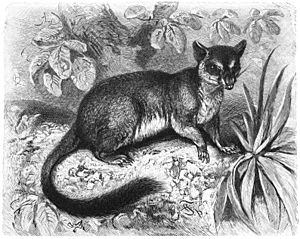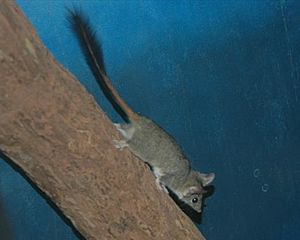Phascogale facts for kids
Quick facts for kids Phascogale |
|
|---|---|
 |
|
| Brush-tailed phascogale (Phascogale tapoatafa) | |
| Scientific classification |
|
| Kingdom: | Animalia |
| Phylum: | Chordata |
| Class: | Mammalia |
| Infraclass: | Marsupialia |
| Order: | Dasyuromorphia |
| Family: | Dasyuridae |
| Subfamily: | Dasyurinae |
| Tribe: | Phascogalini |
| Genus: | Phascogale Temminck, 1824 |
| Type species | |
| Didelphis penicillata Shaw, 1800
(= Vivera tapoatafa, F. Meyer, 1793 |
|
| Species | |
|
See text |
|
The phascogales (members of the eponymous genus Phascogale), also known as wambengers or mousesacks, are carnivorous Australian marsupials of the family Dasyuridae. There are three species: the brush-tailed phascogale (Phascogale tapoatafa), the red-tailed phascogale (P. calura), and the northern brush-tailed phascogale (P. pirata). As with a number of dasyurid species, the males live for only one year, dying after a period of frenzied mating. The term Phascogale was coined in 1824 by Coenraad Jacob Temminck in reference to the brush-tailed phascogale, and means "pouched weasel". All three species are listed as either Near Threatened or Vulnerable by the IUCN.
Contents
Phylogeny
The following is a phylogenetic tree based on mitochondrial genome sequences:
| Dasyuromorphia |
|
||||||||||||||||||||||||
Species
The genus consists of the following three species:
- Brush-tailed phascogale – Phascogale tapoatafa
- Red-tailed phascogale – Phascogale calura
- Northern brush-tailed phascogale – Phascogale pirata
Life cycle
Mating generally happens between May and July. All males die soon after mating. Females give birth to about 6 young ones about 30 days after mating. Phascogales do not have the true pouch that is found in most other marsupials [1][2]. Instead, they form temporary folds of skin - sometimes called a "pseudo-pouch" [3] around the mammary glands during pregnancy. Young stay in this pseudo-pouch area, nursing for about 7 weeks before being moved to a nest where they stay until they are weaned at about 20 weeks of age. Females live for about 3 years, and generally produce one litter.
- Groves, Colin (16 November 2005). Wilson, D. E., and Reeder, D. M. (eds). ed. Mammal Species of the World (3rd edition ed.). Johns Hopkins University Press. pp. 31–32. ISBN 0-801-88221-4. http://www.bucknell.edu/msw3.
- Brush-tailed Phascogale fact sheet: [4]. Also: [5]
- Red-tailed Phascogale fact sheet: [6]. Also: [7]
See also
 In Spanish: Tafas para niños
In Spanish: Tafas para niños


